#Maui renters
Explore tagged Tumblr posts
Text
Okay so I want to note I'm not from Hawai'i so I'm not familiar with the exact situation. But I know the theory.
Basically, Airbnb is bad everywhere housing is expensive. Because Airbnb drives rent prices through the roof by significantly reducing the number of available units. That's because a lot of landlords will turn their rentals into airbnbs because they mean ten times the profit.
This means housing in general gets more expensive, and it especially gets more expensive and harder to get for renters. It reduces the available units and often in large cities there also isn't enough housing to begin with. It's also a gentrifying force and destroys entire neighbourhoods.
Hawai'i has, I believe, the compounding factor that Hawai'ians are already struggling to get housing after the Maui wildfires, and a lot of non-Hawai'ians are buying vacation homes, leaving the housing market very short of housing.
Tldr: Fuck Airbnb
I saw someone else reblog that this won't be effective/ just shift the problem. I don't know about Hawai'i and this specific law to have an opinion on whether or not they are right.

Source

82K notes
·
View notes
Text
[...]
To do this right, we need to hear from anyone who has been touched by this issue. You can help us ensure our stories are comprehensive and nuanced and that they reflect what is happening in your life. If you’re a property owner or landlord, we want to hear your thoughts on the governor’s emergency order barring most evictions and rent increases. If you are a property manager, real estate agent or someone else with expertise in Maui’s housing market, we’d like to hear from you. If you work for a government agency, contractor or nonprofit aid group, we’d like to hear from you, too. And, of course, we want to hear from renters: people who had to leave their homes so wildfire survivors could move in, those who faced rent increases, those who have been told their leases will not be renewed and those who have left Maui.
[...]
I don't think I have any followers that this would affect, but if you think you could reach people by reblogging this, I'd really appreciate it. The housing/rent crisis in Hawaii has always been bad, but now it's just so much worse, and maybe ProPublica can get it the attention it deserves.
0 notes
Text
SEEN YESTERDAY ON FREE HAWAI`I TV
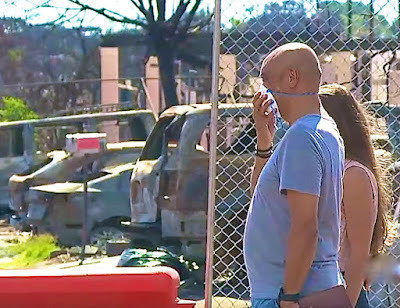
KHON2.com - Gov. Josh Green announced that he backed down from a moratorium on short-term rentals in Maui County on Wednesday, March 27. Community organizers are now focused on legislation that would give power to the counties to phase out high-priced vacation homes. Members of the Lahaina Strong community group gathered at the Hawaii State Capitol on Thursday, March 28 and said they understand a moratorium is no longer needed since displaced families have started to trickle into more permanent housing. “We still need to tackle this short-term rental issue,” Lahaina Strong organizer Paele Kiakona said. “Because the short term rental industry has exacerbated the housing market and made it way too expensive for anybody to even afford a family home here in Hawaii.” Organizers are now highlighting legislation — HB1838 and SB2919 — that would give counties the power to gradually phase out short-term rentals. “Giving counties the clear authority to phase out vacation rental uses is a key tool for helping Maui residents find adequate rental housing in the wake of the wildfires,” Lahaina Strong organizer Katie Austin said. Rep. Elle Cochran added cutting through the red tape to find long-term housing is simply too much for some residents who are still displaced. Organizers said 60% of Native Hawaiians in West Maui who were affected by the fire have left the island. “Every time they get a different case manager, they have to re-tell their story,” Rep. Cochran said, “they have to get this paper, get it signed, go back, I mean, it’s just been nonstop. We’re almost nine months in and we still haven’t built a home?” Some new help is available. The Office of Hawaiian Affairs announced one-time grants for Native Hawaiians affected by the fires — $9,000 to eligible homeowners and $4,000 to eligible renters. “People wonder if things are forgotten, if Lahaina is forgotten,” Hawaiian community advocate Archie Kalepa said. “This is a reminder for our community, the help is there.” The State also announced it has acquired a former hotel in Kihei with 175 guest rooms to be used initially as temporary housing for the displaced and eventually repurposed as a teacher and workforce rental housing project. Hale ʻO Lāʻie — formerly the Haggai Institute property — is expected to open to wildfire survivors in early May, 2024.
#Fishing For Lahaina#Lahaina Strong#Maui Strong#Empower The People#Pono Over Profits#Homes#Not Hotels#The Huli Has Started#Free Hawaii#Refugees On Their Own Land
0 notes
Link
The county incentives and federal perks are intended to ease the plight of those displaced by the disaster. But some say they're making an already tight rental market even worse.
0 notes
Text
What States Are Best for Buying Rental Property?
Researching the best states to buy rental property is essential if you want to increase your real estate investment portfolio while prices are still cheap. For all types of renters and tourists, the United States alone offers a variety of climates. The following four states offer fantastic opportunity for buying rental homes.
Florida
Over the past fifteen years, there has been a steady rise in demand for rental properties in Florida. Disney World, Universal Studios, and different water parks are among the top attractions for kids and families visiting Orlando. The most sought-after cities for residents are Miami, Orlando, Jacksonville, and Tampa. In South Florida, older people frequently retire and reside seasonally while renting out their homes for half the year.

Hawaii
People travel to Hawaii from all over the world because of the state's warm beaches, diverse culture, and vibrant nightlife. Hawaii attracts tourists because of its beautiful beaches, delectable seafood, watersports, and active volcanoes. Hawaii offers incentives for travel and real estate purchases, and its state property tax rate is the lowest. The biggest tourist experiences may be found in Honolulu, Maui, and O'ahu.
Colorado
The state attracts tourists thanks to its picturesque landscapes, art museums, and outdoor recreation opportunities. Colorado real estate is becoming more expensive, and homes are more likely to fetch a premium than their listed price. In contrast to how quickly they are listed, properties are selling. For their thriving sports scenes, Boulder and Aspen are two cities to consider.
Texas
Over the previous five years, numerous eminent investors and corporations have moved offices and operations to Texas towns. Austin, Houston, and Dallas are the three most visited cities, although mid-sized cities like Frisco and Round Rock are expanding. The second-largest state in terms of both population and area is Texas.
You can choose where to acquire homes with cove to fast convert investments into profitable properties by looking into which states are ideal for buying rental property. Do your homework on the real estate, rental, and tourism industries.
#rental property#united states#Beach Property#property management#florida#hawaii#colorado#texas#home#home security#smart home#modern home#real estate#investment property
0 notes
Text
Monday, August 14, 2023
Canadian wildfires could persist for rest of ‘marathon’ summer (Reuters) Record-setting wildfires in Canada could potentially continue burning at an abnormally high rate for several more weeks, though the spread of blazes is likely to start diminishing in September, according to federal projections released on Friday. Forest fires have engulfed parts of nearly all 13 Canadian provinces and territories this year, forcing home evacuations, disrupting energy production, and drawing in federal as well as international firefighting resources. Four firefighters have been killed in the line of duty. So far about 134,000 square kilometers (52,000 square miles) of land have been scorched, more than six times a 10-year average, and nearly 168,000 people have been forced to evacuate at some point this season.
Rent reality (NYT) An enduring image of urban American 20-somethings is one of carefree living with friends in spacious apartments, as depicted in shows like “Friends” or “How I Met Your Mother.” That portrayal, never really all that close to reality, is growing further from it in part because of one factor: high rent. For years, we’ve been told that what you pay for housing shouldn’t exceed 30 percent of your monthly income. But that’s not reality for many people, especially because housing costs have soared in the past few years. Many Gen Z adults are setting aside the pursuit of certain passions or career paths, migrating out of big cities or moving back home with their parents. One 24-year-old, Ives Williams, who lives in Baltimore and spends half of his monthly income on rent, said the only way he could see himself owning a home one day was if he bought one with friends. It’d be like “one big sleepover,” he joked. Savannah Scott, a 23-year-old renter in Reno, Nev., told us that she spends about 75 percent of her monthly income on rent. She limits her driving to once a week and buys only basics at the grocery store (“brown rice and beans”). Kellie Beck, 25, in Brooklyn, spends around 40 percent of her income on rent. She shares a room with her partner in an apartment with two other roommates and said she turns down opportunities to spend time with friends.
Judge warns Trump not to threaten witnesses in 2020 election subversion case (Reuters) A federal judge on Friday granted former U.S. President Donald Trump leeway to publicly share some non-sensitive evidence that will be used in his trial on charges of plotting to overturn the 2020 election, but she warned him to tread carefully before making inflammatory public statements about the case. “Even arguably ambiguous statements by the parties or their counsel- if they can be reasonably interpreted to intimidate witnesses or to prejudice potential jurors—can threaten the process,” U.S. District Judge Tanya Chutkan said on Friday. “I caution you and your client to take special care in your public statements about this case. I will take whatever measures are necessary to safeguard the integrity of these proceedings.” “He is a criminal defendant. He is going to have restrictions like every single other defendant,” Chutkan said. “The fact the defendant is engaged in a political campaign is not going to allow him any greater or lesser latitude than any defendant in a criminal case.”
Maui Blaze Kills at Least 93, Highest Wildfire Death Toll in Over 100 Years (WSJ) The wildfire that reduced the historic center of this island town to an ashy rubble has left at least 93 people dead, officials said, making it America’s deadliest wildfire event in over a century. Residents and tourists who were briefly allowed to re-enter West Maui found a blackened landscape of destroyed homes, burnt-out cars and smoldering embers. It will cost over $5 billion to rebuild from the Lahaina fire, officials estimated. The center of Lahaina remained barricaded. People were warned to avoid the area because of toxic particles in the air and advised to wear masks and gloves. The cause of the Maui County wildfires has yet to be determined. Hawaii fire researchers had warned officials in the past about the risk of extreme wildfires in and around Lahaina.
Argentine farmers back conservatives in election, hoping for freer markets (Reuters) In Argentina’s grains fields and cattle ranches, farmers are hoping upcoming elections will bring political change and an end to years of economic uncertainty, ushering in freer markets with fewer currency controls and export limits. The government, battling an acute shortage of dollars, annual inflation scraping 116%, and a fast declining currency, has imposed strict capital controls, limited some exports, and hiked interest rates to 97%. That has made business difficult in one of the world’s top soyoil and meal exporters and No. 3 corn exporter. Many farmers, or “chacareros”, from the wide Pampean plains, the engine room of Argentina’s economy, say they will get behind the conservative opposition as they did in 2015, when they helped propel former President Mauricio Macri to power.
Wolves, once confined to fairy tales, are back in Germany, stirring debate (Washington Post) At first Nancy Denecke couldn’t figure out why the sheep were panicking. “It took me a moment to realize what was coming out of the forest,” said the 37-year shepherdess, recounting one eventful day last summer in northwest Germany. She was grazing her herd in a treelined field when she saw the wolf pounce. Virtually extinct in Germany for more than a century, wolves are flourishing here once again. Their numbers have increased more than sixfold in the past decade, with Germany now home to as many as 161 packs, or about 1,300 wolves. But accompanying their rebound are attacks on livestock—and an emotional debate. The spread of wolves—through Germany and into Belgium, the Netherlands and beyond—has become an issue at the highest levels of the European Union. Last fall, it touched a personal nerve for European Commission President Ursula von der Leyen, when a wolf killed her pony outside her home in northwest Germany. She wrote later that the E.U.’s executive body recognizes “that the return of the wolf and its growing numbers lead to conflict.” At a local level, the conflict pits farmers against conservationists. People on both sides have been accused of taking matters into their own hands: Hunting shelters have been burned down and wolves have been illegally shot.
Russia’s new history textbooks (Washington Post) When classes begin next month, Russian high-schoolers will get fresh history textbooks rewritten to carry Kremlin-approved narratives about the “special military operation” in Ukraine and rivalry with the West—part of a wider government effort to shape how young generations of Russians think about the war and Russia’s place in the world. The new manuscript—aimed at graduating 17-year-olds and covering the time-period from 1945 until now—blames the United States for the ongoing war in Ukraine and includes a quote from President Vladimir Putin in which he falsely asserts that: “Russia did not start any military actions but is trying to end them.” It includes telling sections ranging from “confrontation with the West” to “Ukraine is a neo-Nazi state” to “Russia is a country of heroes,” according to scans of the new book posted by Russian state media. History lessons everywhere are rarely spared from national ideology, and other countries are often viewed through the prism of the country printing the books. But the drastic transformation of Russia’s portrayal of Ukraine and the rest of the world illustrates Putin’s fierce determination to sweep aside the dark pages of Russia’s past.
Ukrainian morgues seeing ‘more or less double’ the fatalities since counter-offensive began (Insider) The Ukrainian summer counteroffensive began in June, and, despite Western allies supplying advanced tanks and weaponry, the country’s recent moves against Russian combatants have resulted in only modest gains—and heavy casualties. The New York Times reported morgues in the country are seeing vastly increased fatalities due to the heightened fighting. “There are many more bodies at the moment,” the outlet reported Taras Svystun, a soldier on a six-man crew responsible for recovering and identifying deceased servicemen, said. The total dead in the local morgues is “more or less double since the counteroffensive” started, added. Though Ukraine doesn’t publicly share the total number of casualties it has sustained, Insider reported General Mark A. Milley, the chairman of the Joint Chiefs of Staff, estimated in February that Ukraine had lost more than 100,000 soldiers since the war began last year.
Americans Held Prisoner in Iran Saw Promise of Better Relations (NYT) When Siamak Namazi traveled to Tehran in the summer of 2015, Iran had just signed a landmark nuclear deal and the government was encouraging expatriates to return home and bring their expertise and dollars. So the 51-year-old Iranian American businessman flew from his home in Dubai to visit his parents and attend a funeral in Iran. But he was arrested and charged with “collaborating with a hostile government”—an allusion to the United States—and eventually became the longest-held American citizen that Iran has acknowledged imprisoning. In January, he went on a hunger strike for seven days to bring attention to his ordeal. On Thursday Mr. Namazi, along with four other dual national Iranian Americans, became part of a prisoner swap deal between Iran and the U.S. “I’ve been a hostage for seven and half years—that’s six times the duration of the hostage crisis,” Mr. Namazi said in an interview from prison in March with CNN, referring to the American embassy staff who were taken hostage in Iran during the 1979 revolution and held for 444 days. In exchange for releasing the Americans, the U.S. agreed to release five Iranians jailed for violating sanctions against Iran, and to release about $6 billion of Iran’s frozen assets being held in South Korea. The money will be transferred to a bank account in Qatar and can only be used by Iran for humanitarian purposes, such as paying for medicine and medical equipment. The ordeal for the Americans being held in Iran is hardly over. Iran’s foreign ministry said the five will be allowed to board a plane out of Iran only when the money lands in the Qatari bank account. For now, they have been released from prison and remain under house arrest at a Tehran hotel.
Growing Segregation by Sex in Israel (NYT) The trains from Tel Aviv were packed one evening last month when Inbal Boxerman, a 40-year-old mother of two, was blocked by a wall of men as she tried to board. One of them told her that women were not allowed on—the car was for men only. Ms. Boxerman was stunned. It was a public train operated by Israel Railways, and segregated seating is illegal in the country. The men stopping her appeared to be protesters going home from a rally supporting the governing coalition, which includes extremist religious and far-right parties pushing for more sex segregation and a return to more traditional gender roles. Public transportation is the latest front of a culture war in Israel over the status of women in a society that is sharply divided between a secular majority and politically powerful minority of ultra-Orthodox Jews, who frown on the mixing of women and men in public. As part of an agreement with ultra-Orthodox allies that underpinned the formation of the coalition, Mr. Netanyahu made several concessions that have unsettled secular Israelis. Among them are proposals to segregate audiences by sex at some public events, to create new religious residential communities, to allow businesses to refuse to provide services based on religious beliefs, and to expand the powers of all-male rabbinical courts.
0 notes
Text
8/13/2023:. I wish I had a lottery so I can donate to one business person to rebuild their burner business in Maui, and one homeowner to rebuild his/her house, and one renter for money for down payment to rent a place and some rent money. Too bad I don't
0 notes
Text
Buying Maui Beachfront Property

Buying Beachfront Property on Maui Hawaii
If you are thinking about purchasing beachfront real estate on Maui, there are some important factors to consider. Maui boasts some of the most breathtaking beaches in the world, but acquiring beachfront property can be a challenging endeavor. In this blog post, we will explore several key considerations when investing in beachfront real estate on Maui.
youtube
The first factor to take into account when buying beachfront property on Maui is your budget. Beachfront real estate on Maui can be quite costly, so it's crucial to establish a realistic budget before you begin your search. In addition, it's essential to consider the extra expenses associated with owning a beachfront property, such as upkeep, insurance, and property taxes. You must factor in these costs to ensure that you can afford to own a beachfront property on Maui.
Another crucial factor to consider when buying beachfront real estate on Maui is the location. Maui has many spectacular beaches, but not all of them are suitable for real estate investment. You'll want to research the various beachfront communities on Maui and pick a location that fits your lifestyle and investment objectives. Some of the most popular beachfront communities on Maui include Lahaina, Kihei, Wailea, and Kapalua. Each of these areas has its own unique character and appeal, so it's vital to explore them all to find the right fit for you.
Search For Maui Beachfront Properties
When considering location, it's also essential to look to the future. Maui is a renowned tourist destination, and the island's population is growing rapidly. Therefore, the demand for beachfront real estate is likely to increase in the coming years. It's best to find a location with good potential for growth and appreciation. Beachfront properties in developing neighborhoods or areas undergoing redevelopment may offer the most significant potential for long-term appreciation.
youtube
Another important consideration when purchasing beachfront real estate on Maui is the property itself. You should thoroughly inspect the property to ensure that it's in good condition and free of significant defects. It's also crucial to consider the size and layout of the property. If you plan to use the property as a vacation rental, you may want to look for a property with multiple bedrooms and bathrooms. Additionally, you should take into account the outdoor space. A property with ample outdoor space, such as a deck or patio, can be a significant selling point for vacation renters.
When buying beachfront real estate on Maui, it's also important to work with a real estate agent who has experience in this type of property. A qualified agent can help you navigate the complex process of purchasing a beachfront property and provide valuable insights into the local real estate market. They can also assist you in finding properties that meet your specific needs and budget.
Finally, it's crucial to remember that owning beachfront real estate on Maui is an investment in lifestyle. You'll be able to enjoy the magnificent beaches and warm weather year-round, and you may even generate rental income if you choose to rent out the property. However, owning a beachfront property also comes with responsibilities, such as maintaining the property and complying with local regulations. You should be prepared to take on these obligations if you decide to invest in beachfront real estate on Maui.
To sum up, purchasing beachfront real estate on Maui can be a lucrative investment, but it's vital to consider your budget, location, property, and the guidance of a professional real estate agent. By researching your options and thoroughly evaluating properties, you can discover the ideal beachfront property on Maui that meets your lifestyle and investment goals. So, begin your search today and prepare to relish all that Maui has to offer!
If you have any questions about the Maui Real Estate Market, please reach out anytime.
We are Nine Times Network, your go-to Maui Real Estate Team.
Real Estate with Aloha is not just a catchy tagline for us. It is how we conduct business every day.
Adam Miller R(S)81648
808-866-6606
Real Broker, LLC
www.NineTimesNetwork.com
Ten Things to Know Before Moving to Maui
Maui Home Buying Guide
Maui Relocation Guide
Maui Home Sellers Guide
The Ultimate Moving to Hawaii Guide
Top 20 annual Home Maintenance Tasks
Your Guide to Buying a Condo on Maui
0 notes
Text
Maui Fair Housing Training at UHMC
Maui Fair Housing Training at UHMC
There’s a Maui Fair Housing Training at UHMC on Friday, April 12th. The event is intended for landlords, renters, real estate agents, property managers, and condo owners. They’ll discuss fair housing laws and procedures. It’s presented by the County of Maui, Department of Housing and Urban Development, Hawaii Civil Rights Commission, and Legal Aid Society of Hawai‘i. Register online.Free.…
View On WordPress
#County of Maui#Department of Housing and Urban Development#Fair Housing Training at UHMC#Hawaii Civil Rights Commission#Legal Aid Society of Hawaii#maui condo owners#Maui fair housing#maui landlords#maui property managers#maui realtors#Maui renters#Picks of the Week
1 note
·
View note
Text
Kaanapali Real Estate
If you are searching for a Hawaii luxury real estate investment, we invite you to tantalize your senses in one of the most beautiful tropical island locations in the world. Kaanapali is widely celebrated by vacationers, property owners, and renters alike, thanks to its luxurious golf courses, variety of boutique shopping, spas, Maui restaurants, and a thriving beachfront resort community. Paired with white sandy beaches and balmy weather conditions, you will quickly discover why Kaanapali real estate includes some of the top luxury property listings in the Hawaiian Islands. Visit our site here for more details.

#kaanapali real estate#hawaii luxury real estate#finest hawaii properties in kaanapali#residential houses#luxury mansions#luxury condos#luxury homes
2 notes
·
View notes
Text
Day 2 June 1st
After a fun night of animal noises, I naturally woke up at 6AM. We had about an hour drive to Paia where we had reserved our down bill bike tour of Haleakala at 9am. Our camping neighbor recommended us to "grandmas cafe" that was popular for breakfast. We started to pack up, which actually took us about an hour, and stopped at the cafe that was just down the road.
The morning leaving our honey bee sanctuary campground
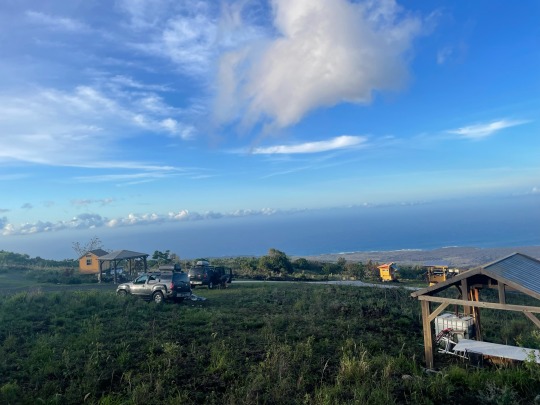
Grandmas cafe was a hole in the wall restaurant but was very busy. Even at 7am there was a line. I ordered a cheese omelet and oatmeal - pretty much what I would eat at home. I regret I didn't order something more Hawaiian like Dan who ordered the fish breakfast plate with rice. Grandmas place was more so known for there baked goods and breakfast breads, but we wanted to hold back until Hana's famous banana bread.
The drive continued to Paia, at almost the same starting point. It was such a cute little town, I wish we had time to explore it more. We arrived at "Maui Sun riders Bike Company." It was about $110 a person to have them drive us up Haleakala, which I would say we were at 6,500 feet when the top top is over 10,000 feet. Once we were dropped off, we coasted down which took about an hour or two with a stop for lunch.
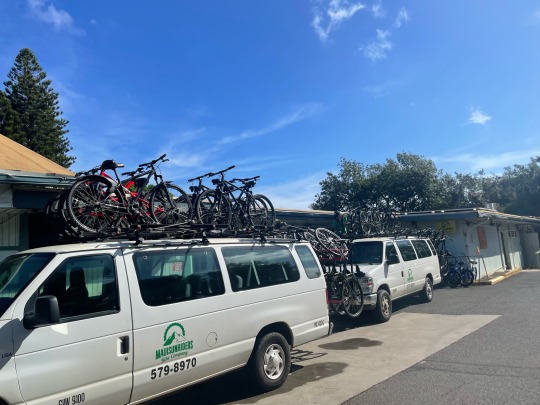
I must say when we reached the top, another bike company was there but with these horrible bikes that look like beach cruisers from the 1950's. This group was also required to go down in a group where we could go at our own speed.
After a 45 minute ride to the near top, we waited for the guide to dismount the bikes. It was cold, windy, and rainy. We were given some serious motocross helmets and were able to head down and meet the guide at the bike shop.
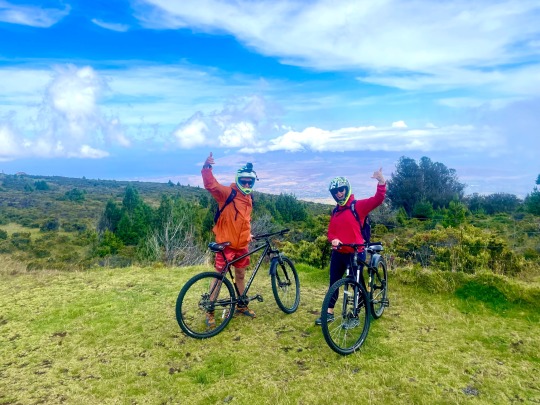
It was actually not bad or scary at all, but that may be because I was applying the break the whole time. It was a fixed gear bike so no amount of peddling would get you anywhere faster. The hill was our only speed. Dan had his hands off the breaks the whole time and had taken full advantage of the speed the mountain provided.
Half way down, we stopped in a really small town and both got some açaí bowls. I personally enjoyed the lower half of the mountains bike ride than the top, it was warm, greener, and more scenic. After finishing and reflecting back on the tour, I would say it was worth it for this one time. This is especially true since we didn't have another window to do Haleakala for camping and hiking during this trip.
After the bike tour, we stopped at Walmart to pick up a few snacks for the campsite.
The jeep operators provided us with information at our second campground that would be in Hana. The woman who ran the campground did not respond to emails, phone calls, or texts as we were last minute and their was bit service at her campground. We were told to get there before five by the jeep renter guy and she should have plenty of space.
This felt like another gamble of the trip as Hana took about 2 1/2 hours to get too. What if we couldn't find the campground or there was no space? I felt a little rude intruding on someone else's property. But we planned for this campground anyways.
Road to Hana mile marker 1

When we first left, we forgot to fill on gas and had to drive 15 minutes back to do so. This was cutting it close for time as we would arrive at 4:45. We drove a straight shot from Paia to Hana. I would not let Dan drive because 1) These roads are narrow and windy and I would rather be in control 2) I'm slower and much more careful. Dan was a good sport (for the most part) letting me drive the whole Hana. He just felt like he was going to die in the passenger seat.
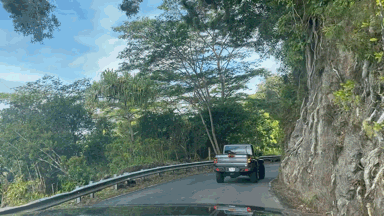
Dan and I passed all the shops and pull offs to hiking and waterfalls - as that is what we planned to do on our way back (tomorrow).
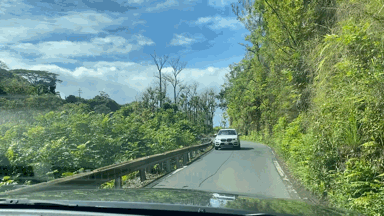
We finally made it to Hana and the campground area. I dropped dan off at the food truck to get us dinner while I hunted down the owner as it was 5pm on the dot. Dan lid $70 for 2 poke bowls and a smoothie - wow.

She came out of this very simple hut, almost like a cabin. She was Hawaiian and really nice and accommodated the fact we didn't have a reservation. I paid $65 for the campsite and was told checkout was at 11. The odd thing was I had to sign a paper I wouldn't tell anybody or post on social media the name or location of the campground. I don't think this counts...
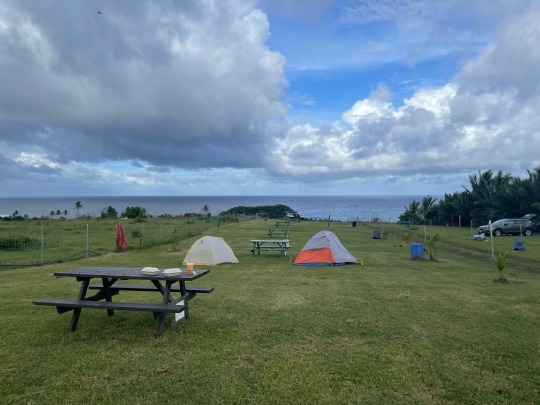
Dan and I set up camp, there was outdoor showers and outhouses. I think my body resists outhouses because I barely needed to use them. The ocean view was gorgeous but unreachable unless we walked 20 minutes to the beach access. It was getting late and Dan didn't want to risk it.
Dan and I tossed the frisbee back and forth a few times and played a few card games. This is where I learn dan doesn't know how to fancy shuffle.


I continuously would get really tired around 7:30, falling asleep by 8/830. This evening I was so Hot in our tent I couldn't sleep. Dan wouldn't let me take the cover off as he was afraid of any flash rain. He also didn't want either side fully unzipped because if it did rain it would get inside. I spent the night pretty uncomfortable due to the heat. At this point I wanted it to rain on me.
0 notes
Photo

We are preparing to open the first phase of the Community-Based Renewable Energy (CBRE) program next week on July 11 for applications by qualified subscriber organizations that wish to build and operate a community solar facility. As approved for implementation by the Public Utilities Commission, the program will provide the benefits of solar energy to residential and commercial customers without access to privately-owned rooftop solar, including many renters and apartment dwellers. The first phase of CBRE aims to bring online a total of 8 megawatts of solar, equivalent to a small grid-scale array, in the Hawaiian Electric, Maui Electric and Hawaii Electric Light service territories. Read more: https://www.hawaiianelectric.com/regulators-approve-community-solar-plans
#CBRE#CommunityRenewableEnergy#RenewableEnergy#Electricity#Community#CommunitySolar#Solar#PV#Solarpower#HawaiianElectric#MauiElectric#HawaiiElectricLight
1 note
·
View note
Link
$300 a day for a Kia Rio. Why rental cars prices have gone insane A year ago, air travel came to a near halt, leading to a glut of rental cars. Rental companies parked their cars in unused lots at ballparks around the nation, and cars were rented for a fraction of their normal price — or sold as used cars. The industry sold off more than a half a million cars, about a third of their combined fleets, just to generate cash they needed to survive the crisis. Last weekend in Florida, 18 of the state’s 20 largest airports were totally out of cars, according to Jonathan Weinberg, the CEO of AutoSlash, a site that helps car renters find the lowest price. He said cars were also sold out at the airport in Phoenix and much of Hawaii. He expects the same to be the case this coming weekend, and most upcoming weekends into the summer for those who wait to reserve a car. “We’re looking at rates of $500 a day in some places,” he said. “Last spring we were seeing $5 a day rentals in Hawaii. You’d never seen that. Now you’d kill for a car for $300 a day.” A search of car rental sites Wednesday showed a Kia Rio, a sub-compact car, going for $300 a day in Orlando, next week. On Maui, Hawaii, the only rental available next week is a Yukon for $500 a day. The shortage is pronounced in vacation destinations. It’s still possible to find cars elsewhere, such as Omaha, for about $300 a week, rather than a day. “Rental car supply is normally tight around spring break, but not like this,” said Chris Woronka, analyst at Deutsche Bank who follows the industry. “Normally you have 30% more cars.” He predicted a number of spikes in travel prices above 2019 levels as travelers start to return, especially for those who don’t book in advance. The providers — airlines, hotels or car rental companies — don’t want to bring capacity back too fast only to see travel fall off again. “I do think you’re going to have this period of readjustment,” he said. “During this period of pent-up demand for travel but not enough supply, you should expect prices would be higher than in the past. The travel providers are testing the waters. We’re in uncharted territory. They’ve all lost a lot money in the last year.” While airlines grounded planes and hotels have closed some floors or temporarily shut in some cases in 2020, it was easier to bring that capacity back online with rebound in travel. “Rental cars are an extreme example,” Woronka said. Book way ahead Car rental companies declined to comment directly on the prices or their supply of vehicles, but they confirmed that the situation is extremely tight, and recommend that customers book well in advance of their travel. “There are challenges in new vehicle supply, due in part to the recent global chip shortage impacting new vehicle availability,” said Sara Miller, spokesperson for Enterprise Holdings, which includes the Enterprise, Alamo and National car rental brands. “We are working closely with our partners to continue to add vehicles to our fleet … [and moving] vehicles where possible to support regional spikes in demand.” Hertz, which is in the process of trying to win court approval to emerge from bankruptcy, also includes Dollar and Thrifty rental car brands. It sold more than 200,000 of its US fleet last year, about 42% of its supply, leaving it with just less than 300,000 US cars in the fourth quarter. Rival Avis Budget (CAR) sold 25% of its fleet. Privately held Enterprise does not report results. “We’re seeing a surge in demand for leisure travel in vacation destinations across the industry, particularly around peak travel times like spring break. Given where the industry was during this time a year ago, we’re happy to help travelers return to the road safely,” said Lauren Luster, spokesperson for Hertz. “Because of the spike in demand and tighter fleets across the car rental industry, availability may be more limited.” The rental car companies have started buying cars again, but after losses last year and air travel still only about half of what it was in 2019, those purchases are at a slower pace than pre-pandemic levels. Purchases of new cars by the rental companies were down more than 90% in May and June as last year. They’ve now purchased nearly 400,000 cars in the last five months, but down about 40% from its year earlier purchases, according to data from Cox Automotive. “The car rental companies would rather not have enough supply and see some higher prices than become overfleet again because they overestimated the rebound,” said Woronka. Source link Orbem News #Cars #Day #insane #Kia #Prices #rental #Rio
0 notes
Text
$300 a day for a Kia Rio. Why rental cars prices have gone insane
New Post has been published on https://appradab.com/300-a-day-for-a-kia-rio-why-rental-cars-prices-have-gone-insane/
$300 a day for a Kia Rio. Why rental cars prices have gone insane
A year ago, air travel came to a near halt, leading to a glut of rental cars. Rental companies parked their cars in unused lots at ballparks around the nation, and cars were rented for a fraction of their normal price — or sold as used cars. The industry sold off more than a half a million cars, about a third of their combined fleets, just to generate cash they needed to survive the crisis.
Last weekend in Florida, 18 of the state’s 20 largest airports were totally out of cars, according to Jonathan Weinberg, the CEO of AutoSlash, a site that helps car renters find the lowest price. He said cars were also sold out at the airport in Phoenix and much of Hawaii. He expects the same to be the case this coming weekend, and most upcoming weekends into the summer for those who wait to reserve a car.
“We’re looking at rates of $500 a day in some places,” he said. “Last spring we were seeing $5 a day rentals in Hawaii. You’d never seen that. Now you’d kill for a car for $300 a day.”
A search of car rental sites Wednesday showed a Kia Rio, a sub-compact car, going for $300 a day in Orlando, next week. On Maui, Hawaii, the only rental available next week is a Yukon for $500 a day.
The shortage is pronounced in vacation destinations. It’s still possible to find cars elsewhere, such as Omaha, for about $300 a week, rather than a day.
“Rental car supply is normally tight around spring break, but not like this,” said Chris Woronka, analyst at Deutsche Bank who follows the industry. “Normally you have 30% more cars.”
He predicted a number of spikes in travel prices above 2019 levels as travelers start to return, especially for those who don’t book in advance. The providers — airlines, hotels or car rental companies — don’t want to bring capacity back too fast only to see travel fall off again.
“I do think you’re going to have this period of readjustment,” he said. “During this period of pent-up demand for travel but not enough supply, you should expect prices would be higher than in the past. The travel providers are testing the waters. We’re in uncharted territory. They’ve all lost a lot money in the last year.”
While airlines grounded planes and hotels have closed some floors or temporarily shut in some cases in 2020, it was easier to bring that capacity back online with rebound in travel.
“Rental cars are an extreme example,” Woronka said.
Book way ahead
Car rental companies declined to comment directly on the prices or their supply of vehicles, but they confirmed that the situation is extremely tight, and recommend that customers book well in advance of their travel.
“There are challenges in new vehicle supply, due in part to the recent global chip shortage impacting new vehicle availability,” said Sara Miller, spokesperson for Enterprise Holdings, which includes the Enterprise, Alamo and National car rental brands. “We are working closely with our partners to continue to add vehicles to our fleet … [and moving] vehicles where possible to support regional spikes in demand.”
Hertz, which is in the process of trying to win court approval to emerge from bankruptcy, also includes Dollar and Thrifty rental car brands. It sold more than 200,000 of its US fleet last year, about 42% of its supply, leaving it with just less than 300,000 US cars in the fourth quarter. Rival Avis Budget (CAR) sold 25% of its fleet. Privately held Enterprise does not report results.
“We’re seeing a surge in demand for leisure travel in vacation destinations across the industry, particularly around peak travel times like spring break. Given where the industry was during this time a year ago, we’re happy to help travelers return to the road safely,” said Lauren Luster, spokesperson for Hertz. “Because of the spike in demand and tighter fleets across the car rental industry, availability may be more limited.”
The rental car companies have started buying cars again, but after losses last year and air travel still only about half of what it was in 2019, those purchases are at a slower pace than pre-pandemic levels. Purchases of new cars by the rental companies were down more than 90% in May and June as last year. They’ve now purchased nearly 400,000 cars in the last five months, but down about 40% from its year earlier purchases, according to data from Cox Automotive.
“The car rental companies would rather not have enough supply and see some higher prices than become overfleet again because they overestimated the rebound,” said Woronka.
0 notes
Text
IS THE US OCCUPATION OF HAWAI`I WORKING?
Honolulu Civil Beat - April 5, 2018
Janet Mason’s head was spinning Tuesday.
The chair of the legislative committee for the League of Women Voters tracks and testifies on dozens of bills as they move through the Hawaii Legislature on topics like government transparency, campaign finance reform, all-mail voting and how lawmakers want to spend taxpayer money.
But in all her years at the Capitol, she’s never seen so many dramatic changes made in bills with so little advance notice, especially this late in the legislative process. The current session, which ends May 3, is about to enter the period where House and Senate lawmakers negotiate the final versions of bills that have already passed both chambers.
“It’s crazy,” Mason said.
Other good-government advocates such as Common Cause Executive Director Corie Tanida and even some lawmakers are also concerned about the trend.
“It’s not just problematic to the public but also to legislators,” Tanida said. “Are they getting the opportunity to fully digest all these bills? They’re not simple bills. And if this is affecting the community, the community needs to have input from the outset.”
Common Cause, the League of Women Voters and other nonprofits, such as Hawaii’s Thousand Friends and Americans for Democratic Action, have called on the Legislature for years to end “misleading practices which keep the public in the dark,” as their 2013 petition to the House and Senate put it.
There’s the gut-and-replace tactic, which involves removing the entire contents of a bill and inserting the contents of another in its place without any notice. And there are the “Frankenstein” bills that keep the original contents of one bill and add the contents of another that had died earlier in the session.
A common practice this session combines both tactics while giving a couple days’ advance notice. Gut-and-replace 2.0.
It’s at equal turns an improvement, in that it at least offers the public a brief chance to see the bill and comment on it before decision-making, and a setback, because it increasingly supplants the more open regular legislative process.
On Thursday, the Senate Ways and Means Committee, chaired by Sen. Donovan Dela Cruz, had an agenda featuring at least a dozen such bills — more than Capitol observers could recall ever seeing at one time. Four bills were deleted from that agenda late Wednesday.
Other committee chairs have also made ample use of this tool. Rep. Sylvia Luke, who chairs the House Finance Committee, gutted a Senate bill from last year that would have expanded the income tax credit for low-income renters and replaced it last month with legislation to give the neighbor island counties more hotel tax revenue.
It’s a tactic allowed under the rules that each chamber sets for itself, and has even been used on some of the biggest issues such as managing telescope activities atop Mauna Kea and protecting undeveloped land.
House Bill 2304 initially would have established the Industrial Hemp Special Fund to pay for a pilot program.
It cleared the House on March 1 after going through the Agriculture and Finance committees. Members of the public and department heads testified on it and a few minor changes were made.
The measure initially received no traction after crossing over to the Senate. But on Monday its referral to the Agriculture Committee was dropped and the Ways and Means Committee set a hearing for Thursday on a new draft that has nothing to do with hemp.
The draft, only made public when the committee agenda was posted Monday, would appropriate $4.5 million to design and build water systems in east Maui for agriculture and other purposes.
The public and others will have an opportunity to testify in writing or in person at the hearing. But it leaves many people scrambling.
For those who had been tracking the bill when it was about hemp, they now have to change course and try to save that plan through other legislation. And those affected by the new proposal about funding Maui water systems have three days to review the draft and prepare testimony.
The League of Women Voters and Common Cause have started give out the Rusty Scalpel Award each year for bills that lawmakers changed dramatically without providing the public a chance to participate in the process.
Last year, the award went to a bill that started out changing income tax rates to help poor people but morphed into a plan to give $1 million to the Hawaii Tourism Authority to address homelessness in tourist areas.
1 note
·
View note
Text
Rent vs. Buy: The Best Places to Become Homeowners—or Remain Renters
badmanproduction/iStock
The most important question for many potential home buyers isn’t about the quality of the local school districts, whether mortgage interest rates will fall, or commute times. Instead, it’s whether it makes more financial sense to just keep renting, rather than sinking money into the purchase of a home. And it all depends on where you live.
In more than 8 out of 10 counties, 84%, it was cheaper to rent than to buy in the fourth quarter of 2019, according to a recent realtor.com® report. In the past year, it has become better to buy in 26 counties—in part because mortgage rates have dropped under 4% in that time.
The economics team at realtor.com analyzed the 593 counties with at least 100,000 residents where sufficient data was available to come up with its quarterly Rent vs. Buy report. It looks at the percentage of income required to rent and to purchase a home, using listing, rental, homeownership, mortgage, and income data.
“Renting remains the more affordable option in a lot of the country,” says Senior Economist George Ratiu of realtor.com. “However, due to declining mortgage rates, we are seeing buying becoming more financially attractive.”
Smaller counties in the Midwest and South tend to offer lower-priced real estate and a cheaper cost of living than the big cities along the coasts. That’s because land and construction labor are less expensive and there are fewer zoning regulations. Plus, there isn’t as much demand for a limited supply of homes in smaller and midsize cities and the surrounding suburbs and exurbs.
Meanwhile, New York City and ultrapricey (and scenic) California counties on the water dominated the list of the highest-priced counties where it makes more sense to rent. These places tend to have lots of good-paying jobs, lively social scenes, and natural beauty. Six of them had median list prices over $1 million.
“Affordability is driven by geography,” says Ratiu. The most expensive markets have “solid economies and strong job growth, which is very attractive to young professionals. The trade-off is that it’s much more difficult to get a foothold in homeownership.”
So where are the best places to purchase a home, or to rent one?
The best counties to buy a home
Clayton, GA ($154,500 median list price)
Baltimore City, MD ($167,500)
Cumberland, NJ ($142,450)
Richmond, GA ($125,50
Vigo, IN ($89,050)
Wayne, MI ($127,050)
Muscogee, GA ($151,550)
Cambria, PA ($79,950)
Hampton City, VA ($193,00)
Jefferson, NY ($162,500)
The best counties to rent a home
New York, NY ($1,680,550 median list price)
Santa Barbara, CA ($1,395,050)
Monterey, CA ($1,000,050)
San Mateo, CA ($1,643,050)
San Francisco, CA ($1,499,300)
Marin, CA ($1,383,550)
Napa, CA ($995,050)
Los Angeles, CA ($866,550)
Kings, NY (Brooklyn) ($807,050)
Maui, HI ($960,050)
The post Rent vs. Buy: The Best Places to Become Homeowners—or Remain Renters appeared first on Real Estate News & Insights | realtor.com®.
from https://www.realtor.com/news/trends/rent-vs-buy-the-best-places-to-become-homeowners-or-stay-renters/
0 notes